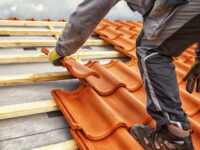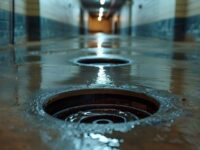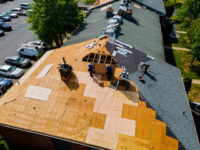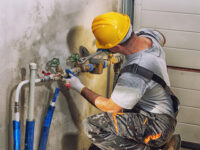Commercial Roof Repair
Commercial Roof Repair Suffolk can be critical to keeping your building and equipment safe and operational. Leaks, damage to shingles and flashing, and poor drainage systems are among the most common reasons for commercial roof repair.
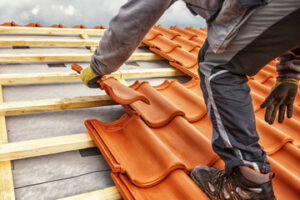
Commercial roofing has its own set of regulations, requiring specialized knowledge for maintenance and repair. A professional can help address issues before they become more serious, saving you time, money and disruption to your business operations.
A commercial roof is exposed to a variety of factors that can impact its integrity. These include high winds, severe storms, and the use of mechanical equipment. Unexpected infrastructure failures like roofing issues can disrupt business operations and incur costly expenses. The key to keeping your commercial roof intact is regular inspections and timely repair work.
A damaged roof can lead to leaks and structural damage. It can also affect the comfort of your employees and customers. If you spot any signs of roof problems, it’s important to contact a professional commercial roofing contractor right away.
The most obvious sign of a damaged roof is missing or broken shingles. These can be caused by various factors, including age, sun exposure, and poor ventilation. Damaged shingles should be replaced or repaired as soon as possible to prevent more extensive and expensive damage.
Missing shingles can allow water to penetrate the roof, leading to a number of issues, such as mold and rot. The presence of moisture can also compromise the structural integrity of your building and increase energy costs.
While you can try to replace a shingle yourself, it is best left to the professionals. Before a roofer begins the job, they will assess the extent of the damage and determine whether a full replacement is necessary. They will then remove the existing shingle and install a new one, matching it as closely as possible. The roofer will then nail the shingle in place and apply a layer of roof sealant to protect it from future damage.
A well-maintained roof will enhance the aesthetics of your building and can add to its resale value. It will also provide protection for valuable merchandise and equipment, as well as preventing the penetration of water into your building.
To prepare for a shingle repair, you will need a few basic tools. A sturdy ladder is a must, as is a flat pry bar and a hammer for driving new roofing nails. A utility knife can be helpful for trimming or cutting shingles to size. It is also a good idea to have a tube of roof sealant available to seal any cracks and gaps. Finally, make sure that the area where you are repairing is clear of obstructions and other items. This will speed up the process and prevent potential injuries.
Leaks
When a commercial roof has a leak, it can cause damage throughout the entire structure. Water stains on ceilings, wet insulation, and interior mold growth are all serious issues that require prompt action. Not to mention the potential for slip and fall accidents among employees, customers, and tenants.
Commercial Roof Leaks can be caused by a variety of factors, including membrane issues, lack of maintenance, and severe weather events. If left unchecked, leaks can worsen over time, resulting in expensive repairs and even structural damage.
Having a regular commercial roof maintenance schedule can help identify problems before they turn into leaks. During routine inspections, professionals look at the surface of the roof, openings and other outlets, perimeter, and any areas with sealant. They can also check for any signs of cracks or changes to the membrane and flashing.
Many commercial roofs have a drainage system to remove excess water. However, these systems can become damaged due to poor installation, ageing or clogging. When this occurs, water can start pooling on the roof and seep into gaps and crevices, eventually causing leaks.
Other causes of leaks include metal flashing, which is used to join different parts of the roof. It is important to have the correct flashing materials installed and to keep them in good condition.
Blistering is another common issue that can lead to commercial roof leaks. This happens when the air is trapped between layers of felt or plies, causing them to expand and split. These blisters are often caused by heat, wind, and ponding water.
Leaks in a commercial building aren’t just damaging, they’re dangerous too. They can cause injuries to people who work or visit the property. This is why it’s so important to be aware of the warning signs and take immediate action.
Damaged Flashing
The flashing is the first line of defense against water damage. It is installed on the roof at critical areas including chimneys, walls, vents, skylights, and roof valleys. Flashing is a thin sheet of metal that directs water to the shingle area where it can be shed off. When flashing is damaged, it must be repaired immediately. If water gets in around the flashing, the roofing system will be compromised and leaks may develop.
Commercial roofs are more vulnerable to damage than residential ones because they are larger and have a greater surface area. Commercial roofs also contain valuable equipment and materials that must be protected from the elements. Leaks, ponding water, flashing problems and other urgent commercial roof repairs need to be addressed immediately to minimize the risk of expensive interior damage.
In addition to repairing leaks, commercial flat roof repair often involves replacing or resealing flashing. This is especially important if it is worn or damaged, as this can lead to leaks and other serious problems. The roofing professionals at Whitney Roofing can quickly and effectively repair or replace damaged commercial roof flashing, providing a secure and waterproof barrier for the roof.
Many commercial roof problems can be prevented with regular inspections and prompt repair of any issues that arise. However, even the best commercial roofs can be damaged by unforeseen circumstances. In these situations, it is crucial to have a commercial roof maintenance plan in place that can address issues as they arise.
Commercial roofing is more complicated than residential roofing, and requires specialized materials and techniques. While a commercial roof is expected to last 30 years, a variety of factors can shorten its lifespan. Commercial roofs are exposed to extreme weather conditions, debris and the daily wear and tear of building occupants. Damage can occur due to these factors, as well as poor construction and aging materials. A damaged commercial roof can impact the overall integrity of a building, causing interior stains and water leaks that require costly repairs.
Ponding Water
Ponding water is a commercial roof repair problem that, left untreated, can lead to severe damage. Water that doesn’t drain puts additional weight on a roof, which the structure and insulation weren’t designed to support; this can compromise structural integrity and result in leaks. It also promotes deterioration of the roof membrane, which accelerates aging and limits future flat roofing repair options.
In addition, puddles of standing water create slip and fall hazards for rooftop workers. They can also freeze in winter, creating ice sheets that are hazardous to walk on. Additionally, the ponding water may contain environmental debris like leaves and twigs. This creates an attractive environment for birds and insects, which can cause a nuisance and disrupt your business operations.
Another issue with ponding water is that it can encourage the growth of algae, plants and mold. These substances thrive in damp environments and are difficult to eradicate once they get a foothold on a roof. They can then spread throughout a facility, resulting in subpar indoor air quality for employees and customers.
In many cases, the underlying problem that causes ponding is a lack of proper slope or poor roof design. A commercial roof expert can identify these issues and recommend long-term solutions. These solutions might include installing a new, proper slope to the roof or removing low spots that are not adequately drained.
While it’s important to follow a proactive maintenance plan for your commercial roof, sometimes emergency repairs are necessary. A commercial roof expert can identify and resolve leaks, ponding water and other problems to protect your facility’s interior and prevent further damage.

